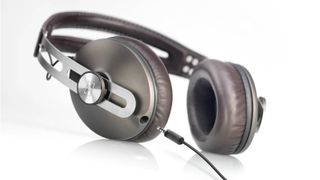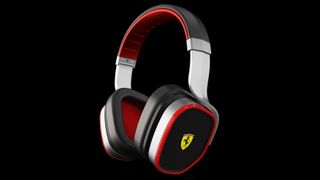Best headphones: 10 top headphones for sound quality
High-end headband and in-ear headphones
Happily, there's a reward in the form of excellent, highly detailed sound. Don't expect a bass-heavy performance, but rather one that picks out some fine detailing and stereo separation within a rounded, realistic soundscape.
Sennheiser Momentum - £260/US$350/AU$400

A closed dynamic model, Sennheiser's latest headphones weigh just 190g (6.7oz) yet manage to achieve a remarkably high standard of build, design and sound quality.
Let's get straight to the music; it's so detailed, so involving and so utterly crystal clear that we're sure we heard the cello player breathing. The balance between treble details and low frequency is quite something - it sounds uncomplicated, uncompromised, and just natural.
On a par with the Grado Labs Prestige Series SR125i headphones and perfect for the modern musician about town, the Sennheiser Momentums are just so versatile. There's very little spillage, so they're great for the office, and they're easy to travel with thanks to their lightweight, narrow design - though there's no noise cancelling option.
We're not so sure about the 277g (9.8oz) of the carry case - it's far to big. Inside its moulded but soft innards is a secret Velcro door that reveals a 6.35mm jack plug adaptor and a plain alternative to the audio cable with iPhone navigation. Both are red, 125mm (49 inches) in length and terminated on a hinge to either enter a device straight-on, or at an L-shaped angle. That's a nice detail, and typical of these truly brilliant headphones.
PSB M4U 2 - £270/US$400 (around AU$420)

A second bite of the cherry for PSB, but this time it's all about noise cancelling that's not only among the best out there, but is purely optional; if the batteries die while you're travelling you can still listen to music. At last.
Running out of batteries mid-flight is therefore not the major worry it is with the Bose QuietComfort 15 and Ferrari by Logic3 R300 products featured here, but there's more to like here than versatility.
Get daily insight, inspiration and deals in your inbox
Get the hottest deals available in your inbox plus news, reviews, opinion, analysis and more from the TechRadar team.
In fact, sound quality with noise cancelling mode deactivated - passive mode - is the equal of its highly impressive sibling, the M4U 1. For noise-cancelling, these circumaural headphones keep everything out, and in two positions; a slider on the back of the right ear cup activates noise-cancelling while also offering a battery-saving amp so music can go to louder volumes without the white-noise production. Nice idea.
As is the in-line iPhone/BlackBerry control and the spare pair of ear cup pads. With the same surprisingly compact folded position that makes them great for travelling despite their rather large headband, the gyro-suspension of the comfy ear cups, and the choice of side for the cable input, the M4U 2s are a great choice for noisy environments.
Ferrari by Logic3 R300 - £270 (around US$410/AU$420)

Part of Logic3's Scuderia Ferrari Collection, these noise-cancelling headphones' circum-aural design helps achieve a very quiet environment for the wearer, though despite the closed-back design, there's a lot of sound spillage, which makes them unsuitable for using in an office.
A Ferrari logo'd pause button on the outside of one of the cups - useful for when an air hostess asks which kind of champagne you'd like - is another give-away as to their intended destination, and a nice touch indeed.
In loud environments they do rather well, keeping out ambient noise and reaching impressively high volumes without distorting, but without their 3x AAA batteries they don't work at all. High treble detail can seem a little muffled; there's a definite emphasis on the other end of the spectrum, with deep and driving bass lines, though what acoustic music lacks in fine detail it gains in presence, which is crucial at 40,000ft. It's a powerful sound with plenty of presence.
Jamie is a freelance tech, travel and space journalist based in the UK. He’s been writing regularly for Techradar since it was launched in 2008 and also writes regularly for Forbes, The Telegraph, the South China Morning Post, Sky & Telescope and the Sky At Night magazine as well as other Future titles T3, Digital Camera World, All About Space and Space.com. He also edits two of his own websites, TravGear.com and WhenIsTheNextEclipse.com that reflect his obsession with travel gear and solar eclipse travel. He is the author of A Stargazing Program For Beginners (Springer, 2015),

